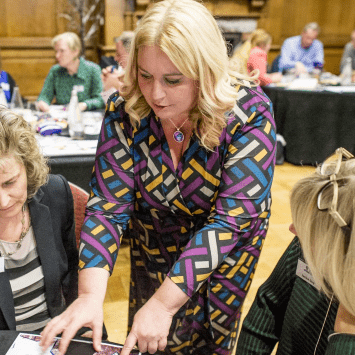Posted in Blog, Facilitation, Virtual Facilitation by Jo North
Lead Productive, Effective, and Fun Retrospective Meetings
How are your retrospective meetings going? 🤔
Are they full of energy, actionable insights for your future projects, or have they become a bit stale and same-y?
Are you even doing them at all? Or have they never even started or fallen by the wayside because everyone is “too busy”?
Retrospectives are workshop-style meetings that take place after key phases of project activity, innovation, events, or sprints. They are designed to give you and your team light bulb moments about your success, and how to replicate it, as well as the root cause of things that didn’t go so well, so you can learn from that too.
Effective retrospectives drive continuous improvement and are a fundamental part of how high performing teams achieve their goals faster, with less risk and better outcomes.
Whether you’re new to leading retrospective meetings or looking to improve your existing approach, my aim is that this article will give you the tools and knowledge you need to succeed.
In this article, I share a comprehensive guide to leading productive and effective retrospective meetings. I’ve designed this content for leaders who want to facilitate open and honest discussions that drive real results.
Contents
- What is a retrospective meeting?
- The roots of retrospective meetings
- How do Agile sprints work?
- The importance of retrospective meetings
- When should you have a retrospective meeting?
- What makes a great retrospective?
- How to facilitate difficult or sensitive situations in your retrospective
- A retrospective meeting agenda template with a menu of 25 different team activities to choose from
What is a retrospective meeting?
A retrospective meeting is also known as a lessons learned meeting or workshop, a post mortem or review session. It is sometimes called a ‘retro’ for short.

A retrospective is a workshop-style meeting that takes place after key phases of project activity, innovation events, sprints and so on. It’s designed to give you and your team light bulb moments about your success and how to replicate it in the next piece of work that you do. You’ll also identify what didn’t go so well so that you can put in place fixes, work around solutions, and learn from your experience.
A great retrospective meeting explores how well people collaborated as well as how effectively tasks were completed.
Holding retrospective meetings is a great best practice for building continuous improvement into your organization’s DNA.
The roots of retrospective meetings
The roots of retrospective meetings are in agile methodology, created by and for development teams over 20 years ago.
Agile methodology is a project management approach that breaks the project up into several phases. The team works closely with stakeholders throughout and focuses on continuous improvement at key milestone stages. Once the work begins, the team goes through a process of planning, implementing, and reviewing.
“At regular intervals, the team reflects on how to become more effective, then tunes and adjusts its behavior accordingly.”
Agile Manifesto

How do Agile sprints work?
Agile sprints are a key part of the Scrum framework in agile software development. Each sprint is a short development process that typically lasts one to two weeks, or sometimes up to a month. At the end of each sprint, the Scrum team holds a sprint retrospective meeting, which is a type of retrospective meeting that focuses on the previous sprint. The purpose of the sprint retrospective is to reflect on the previous sprint and identify areas of improvement for the next sprint.
During the retrospective session, the entire team, including the Scrum Master, Product Owner, and development team members, come together in a safe space to discuss the previous sprint. The retrospective template usually includes questions that help the team reflect on what went well, what didn’t go well, and what could be done better in the future. The team may also vote on action items and process improvements that they want to implement in the next sprint.
The Scrum Master Plays a Key Role
The Scrum Master plays a key role in facilitating the retrospective meeting and ensuring that everyone has enough time to provide honest feedback. They may use retrospective ideas and best practices to encourage the team to reflect on past mistakes and identify new ways to improve the work process. The Product Owner may also provide input on the product backlog and user stories, and the development team members may discuss the sprint goal and the product increment.
At the end of the meeting, the team should have identified actionable items and next steps for the following sprint. The retrospective meeting is just one of the Scrum events that occur at the end of a sprint, along with the sprint review meeting and the sprint planning meeting for the next sprint.
Agile retrospective meetings can also be held at the end of a project or product development cycle to reflect on the entire work process. This type of retrospective meeting involves a neutral third party, such as an Agile coach, who can provide real-time feedback on the team’s progress and offer suggestions for future improvements.
The importance of retrospective meetings
You don’t have to be in tech – software, app development, or other IT areas – to benefit from holding retrospective meetings. They will:
- Drive continuous improvement
- Help you to replicate success
- Accelerate goal achievement
- Cultivate a growth mindset across your team
- Give the team an opportunity to express frustrations and celebrate success
- Reduce risk
- Lead to better outcomes
- Give closure and free up people’s thinking to help them move on to the next stage of the project

When should you have a retrospective meeting?
Retrospective meetings work best for projects or one-off activities and incidents, rather than ongoing business-as-usual tasks. A business improvement workshop is usually a better option for working on day-to-day, recurring processes.
Examples of when to hold a retrospective meeting
- After completing a key stage in a project
- Following the new launch of a new product or service, or when a new product has shipped
- At the end of a significant piece of work, such as:
- Marketing campaigns
- Bids and tender submissions
- Innovation or design sprint
- Creating and delivering an important pitch
- Delivering a training programme, conference, or event
- Unexpected incident, e.g.:
- A business interruption event
- A significant issue for a customer
- At the end of each phase of a longer-term project – i.e. two-weekly, monthly or quarterly

Retrospectives for marketing campaigns, bids and tenders
For marketing campaigns and bid or tender submissions, I recommend that you do two retrospectives.
- The first is as soon as you’ve launched your campaign or submitted your bid or tender proposal. It should focus on your outputs, processes, and collaboration BEFORE you get feedback on how successful your work has been.
- The second takes place once you have got data on the success of your marketing, or the final decision and feedback on your bid or tender. This session focuses on how could repeat your success in the future and learn from your mistakes. Remember to do your retrospective whether you succeed or fail, win, or lose.
How long should a retrospective meeting be?
I recommend that your retrospectives are short – between 30 minutes and 2 hours, depending on what you’re doing one for. The bigger the project, the more people involved and the more complex it is, the more time you’ll need to allow. For smaller activities it’s amazing what you can get done in 30 minutes if you’re focused and plan your workshop well.
What makes a great retrospective?
During your retrospective meeting the team is obviously thinking about what has gone well, and what has not. Sometimes, especially when people have invested a great deal of time and energy into a project that has not gone as expected, they make feel sensitive, vulnerable or emotional about some of the events and outcomes.
Psychological safety
“Psychological safety is a belief that one will not be punished or humiliated for speaking up with ideas, questions, concerns, or mistakes, and that the team is safe for interpersonal risk taking.”
Amy Edmondson, Harvard Business School
Make sure that you create the right environment, one of psychological safety. Trust and psychological safety need to be in place for team members to feel confident about sharing ideas, challenging thinking and speaking out. There should absolutely be no politics and no blame.

“If a team is struggling in its agile transformation, shadow it. Evaluate its dialogic process. Are members respectful? Do they tolerate candor? Do they protect and reward vulnerable behavior? If the answers to those questions is no and members are touchy, temperamental, or territorial, you’ve got work to do.
You may be blessed with resources, expertise, and mastery of technical processes and tools, but ultimately, being agile relies on the ultimate enabler — psychological safety.”
Timothy R. Clark, Harvard Business Review
Checklist of key success factors for a great retrospective meeting
Here is a checklist of all the main key success factors for a great retrospective meeting.
- Make sure it happens when all the major work is done on your project phase, not when there are still significant items to complete.
- Gather data in advance and ask delegates to prepare their thoughts to bring to the meeting.
- Schedule the session for soon after the work has finished – but allow some recovery time, if necessary, for example if the project has been especially tiring or challenging. Sometimes it’s healthy to step away and put a little bit of time in between the work being finished and the retrospective itself. This affords the creative subconscious an opportunity to catch up and reflect, so that people can give a more considered and balanced view.
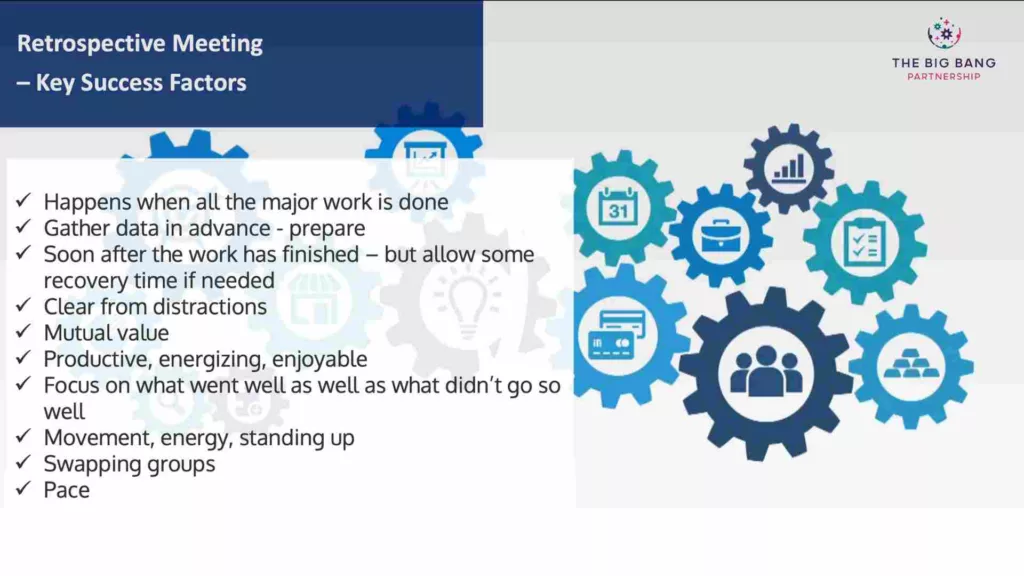
Focus on Creating Mutual Value
- Ask the team to stay clear from distractions to focus on the session.
- Ensure that your retrospective is about creating mutual value. People need to feel like they’re getting something from the retrospective, that they’ve got a space to share ideas, raise issues. They want to know that things are going to be better because of the retrospective meeting.
- Design the session to be productive, energizing, and enjoyable.
- Focus on what went well as well as what didn’t go so well.
- Create movement and energy. Have people standing up, swapping groups. Keep it dynamic and interesting. Make sure the pace is appropriate as well – keep it moving.
- If you run retrospectives frequently using the same get a bit stale. Your workshops risk becoming just another thing to do, a box to tick, rather than something that’s stimulating, stretching and productive.
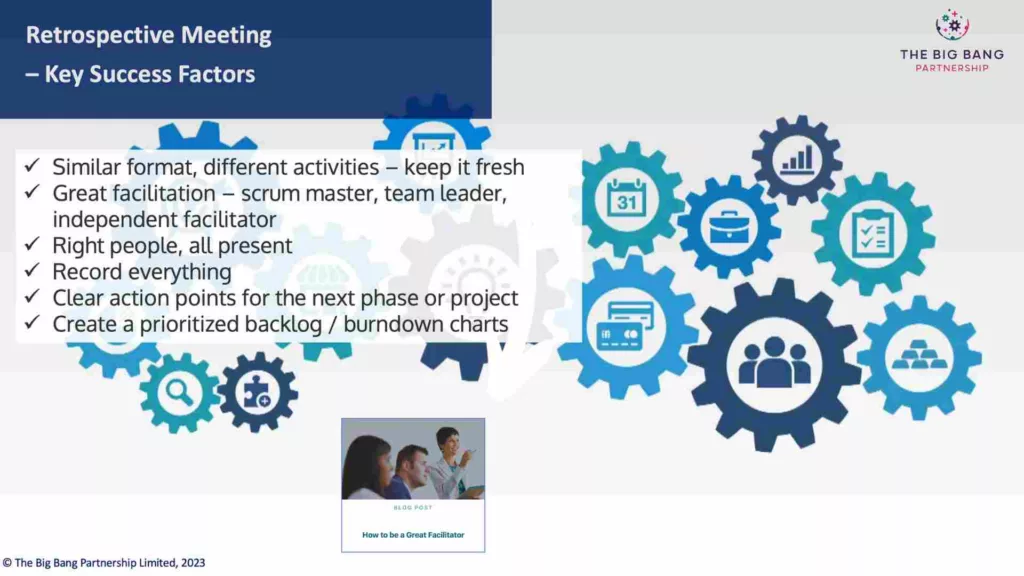
You Need a Great Facilitator
- You need a great facilitator. This could be the Scrum Master (the agile leader or coach for an Agile process), or a team leader. Somebody independent can be helpful because they don’t have embedded perspectives about the process or teamwork.
- Have the right people present. Make sure everybody’s there who needs to be.
- Record everything. Capture the key outputs, with clear action points and create a prioritized backlog. If you’re working on an ongoing project, with retrospectives at regular intervals to assess your process, consider using burndown charts to track how quickly you’re working through resolving issues.
How to facilitate difficult or sensitive situations in your retrospective
Here are some tips to help you facilitate difficult or sensitive situations.
1. Deal with individual performance issues separately
The retrospective is not the place to deal individual performance issues. Instead, have a conversation offline, and do it appropriately. Use the proper process that you’ve got in place to help team members improve their performance within your organization.
2. Go ahead with the retrospective, even if the team dynamic is challenging
If the team dynamic, there is an even greater need to have a retrospective and use these tips and techniques for rebuilding a dysfunctional team.
3. Set clear ground rules
At the beginning of the session, agree a ‘contract’ for behaviors that ensures mutual respect, that what goes on in the room stays in the room, and allows everybody to feel heard and valued.

4. Use an icebreaker or warm up
A well-chosen icebreaker or warm up will set the tone, relax people, help the team to focus on the session and begin to feel psychologically safe.
5. Be sensitive to emotions
Our decisions, our behaviors, our actions, are driven by emotion. There’s some great insight in this article here, The Elephant and The Rider. Be sensitive to that, and to how people are feeling. Make sure people truly listen to each other.
You might want to use activities such as silent brainstorming to give team members time to reflect and contribute calmly and thoughtfully.
Retrospective Meeting Agenda
Here’s a retrospective meeting agenda that you can use to plan your sessions.
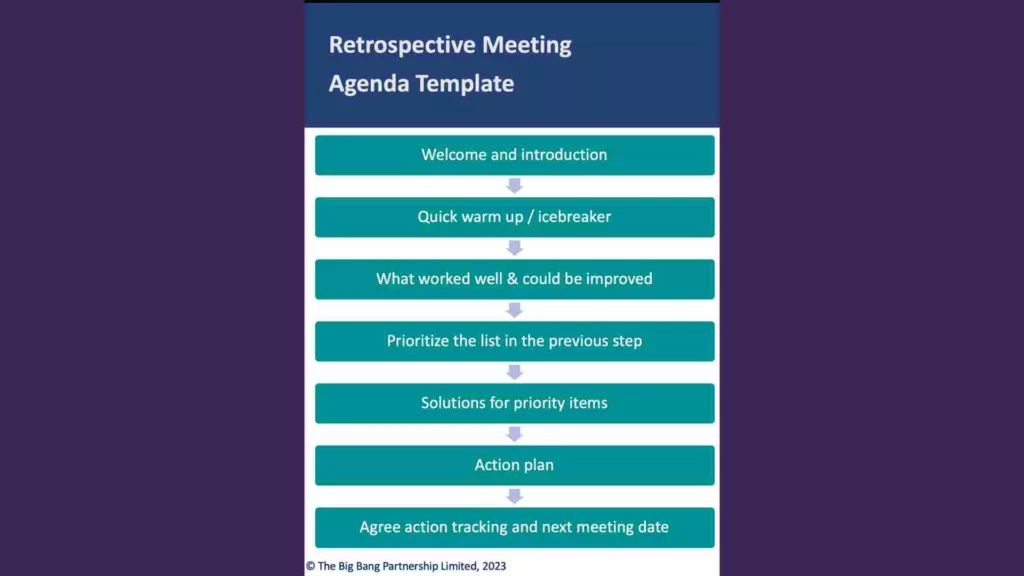
Welcome and introduction
Even if you’re having regular retrospectives, it doesn’t hurt just to spend a few seconds reminding people of the purpose of the session and what the focus will be on. You’ll definitely need to do this if it’s a one-off or first retrospective meeting.
Share the ground rules and ask for agreement to work to them.
Explain that you’re going to use the work from the meeting to drive continuous improvement, so that participants know they’re contributing to something that’s going to be useful.
Quick warm up or icebreaker
Use an appropriate warm-up or icebreaker, even if people know each other. The purpose of this is to get everyone involved in the session straightaway.
If your retrospectives are at regular intervals, add in some time to check in on any outstanding and completed action points from the previous session, before you get into what worked well, and what could be improved.
What worked well and could be improved
Here is a menu of 20 activities that you can select from for the what worked well and what could be improved section of the agenda.
1. One word retrospective
One word retrospective activities are a great way to quickly and easily gather feedback from your participants. Ask each participant to think of one word that describes their experience or feelings about the project/event. Then, go around the group and have each person share their word and briefly explain why they chose it.
You could also create a word cloud or gallery of words on the wall.
2. Mad, Glad, Sad
Divide a whiteboard or a flip chart paper into three sections: Mad, Glad, and Sad. Then, ask each team member to write down at least one thing that made them feel mad, glad, or sad during the project or period being reviewed.
After everyone has had a chance to write down their thoughts, go around the group and ask each to person share their ideas, adding them to the corresponding section on the board.
3. Help and Hinder
Create a chart with two columns: Help and Hinder. Then, ask team members to write down at least one thing that helped or hindered their work during the project or period. Examples of things that could be listed in the Help column include effective communication, access to resources, and positive team dynamics, while things that could be listed in the Hinder column might include unclear expectations, lack of training, or unproductive meetings.
4. Sailboat
Draw a sailboat on a whiteboard or flip chart paper, with the boat representing the project or period being reviewed, the water representing the challenges or obstacles faced, the wind representing the things that propelled the team forward, and the anchor representing any factors that held the team back. Ask team members to write down at least one thing that represents each of these elements, such as a specific challenge or obstacle they faced during the project, a factor that helped propel them forward, or a factor that hindered their progress.
Once everyone has had a chance to write down their thoughts, go around the group and have each person share their ideas, adding them to the corresponding element on the sailboat.
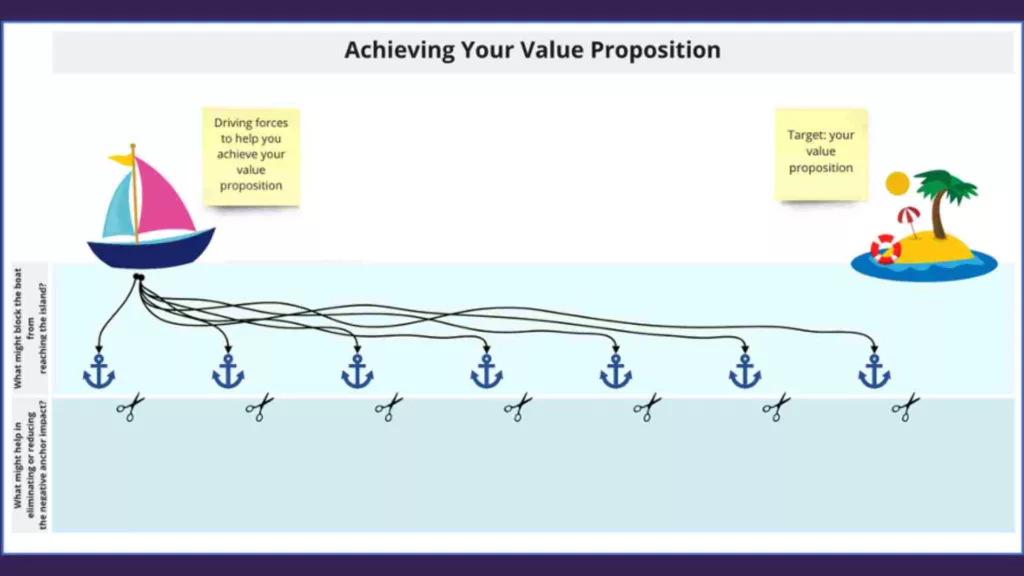
5. Rose, Thorn, Bud
Draw a chart with three columns: Rose, Thorn, and Bud. Ask team members to write down at least one thing that represents each of these elements, such as something positive or successful that happened during the project (Rose), a challenge or obstacle that they faced (Thorn), and an opportunity for growth or improvement (Bud).
6. Stop, Start, Continue
To facilitate this activity, draw three columns on a whiteboard or flip chart paper: Stop, Start, and Continue. Ask team members to write down at least one thing that they think the team should stop doing, start doing, and continue doing in relation to the project or period being reviewed.
Examples might include stopping unproductive meetings, starting to use a new tool or process, or continuing to prioritize communication and collaboration. Once everyone has had a chance to write down their thoughts, go around the group and have each person share their ideas, adding them to the corresponding column on the chart.
As a facilitator, encourage discussion and reflection, asking follow-up questions to gain a deeper understanding of the issues raised.
7. Three Little Pigs
The Three Little Pigs story is used as a metaphor for retrospective meetings, where teams are encouraged to identify short, medium, and long-term actions to improve their process and team dynamic. The story highlights the importance of avoiding quick fixes, managing obstacles effectively, and learning from failures.
The Three Little Pigs Retro activity involves analyzing the current product or technology stack to identify areas that need attention.
The outcome is a review of current gaps and a search for continuous improvement actions that can help mitigate risks. The activity involves categorizing products as house of straw (quick fixes), house of sticks (reliable but improvable), and house of bricks (fundamentally reliable).
Icebreaker questions for the activity include what fairy tale resonates with team members, which pig they identify with, and what their “house of straw” is.
8. 4 Ls
To facilitate the 4 Ls activity, draw four columns on a whiteboard or flip chart paper: Learned, Liked, Lacked, and Longed For. Ask team members to write down at least one thing that they learned, liked, lacked, and longed for during the project or period being reviewed. Examples might include a new skill or knowledge gained (Learned), something they enjoyed about the project (Liked), something that was missing or needed improvement (Lacked), and something they wish they had or hoped for (Longed For).
Once everyone has had a chance to write down their thoughts, go around the group and have each person share their ideas, adding them to the corresponding column on the chart.
9. 5 Whys
The 5 Whys retrospective activity is a useful tool for identifying the root cause of a problem or issue within a team’s project or process. To use the 5 Whys, begin by identifying a specific problem or issue and ask why it occurred. Once the first answer is given, ask “why” again to dig deeper and identify the underlying cause. Repeat this process at least five times, or until the root cause is identified. As a facilitator, encourage open communication and avoid blame, instead focusing on the problem itself and how to address it.
10. Fishbone Diagram
The Fishbone Diagram retrospective activity, also known as the Ishikawa diagram or cause-and-effect diagram, is a useful tool for identifying the root causes of a problem or issue within a team’s project or process.
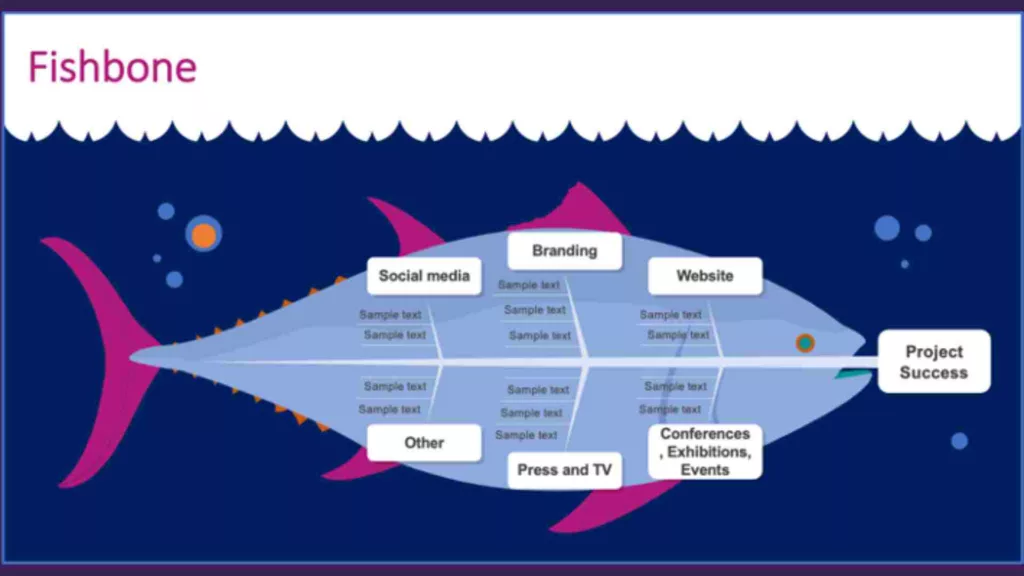
To use the Fishbone Diagram, begin by drawing a horizontal line across a whiteboard or flip chart paper and drawing a box at one end to represent the problem or issue being addressed. Then, draw several diagonal lines stemming from the box, like the bones of a fish, and label each line with a category of potential causes, such as people, process, technology, or environment.
Ask team members to write down at least one possible cause for each category, adding them to the corresponding line on the diagram.
11. Timeline
The Timeline retrospective activity is a useful tool for reviewing a project or period of time, and identifying successes, challenges, and key events.
To facilitate this activity, draw a horizontal line on a whiteboard or flip chart paper, representing the timeline of the project or period being reviewed. Mark significant events or milestones on the timeline, such as project start and end dates, major deliverables, and significant challenges or successes.
Ask team members to add their own events or reflections on sticky notes, and place them on the timeline at the appropriate point.
12. Retrospective Bingo
To facilitate this activity, create a bingo card with different statements related to the project or period being reviewed, such as “I learned a new skill,” “I faced a challenge and overcame it,” or “I worked collaboratively with a new team member.”
Distribute the bingo cards to team members and ask them to mark off the statements that apply to them.
Once someone has completed a bingo line, they can call out “Bingo!” and share their experiences related to the statements on their card.
13. Metaphor
Ask team members to think of a metaphor that represents their experience with the project or period being reviewed. You could ask them to draw their metaphors on a virtual whiteboard or flip chart. For example, they might say “The project was like a roller coaster – there were ups and downs, but ultimately it was a thrilling ride.”
Once everyone has thought of their metaphor, go around the group and have each person share their metaphor and explain how it represents their experience.
14. Force Field Analysis
Draw a vertical line on a whiteboard or flip chart paper and label the top as “Driving Forces” and the bottom as “Restraining Forces.”
Ask team members to identify the factors that are driving progress towards the goal, and those that are restraining progress, writing on sticky notes and adding to the appropriate column on the chart.

15. Color-coded Retrospective
To facilitate this activity, assign a color to each category or area of performance, such as communication, teamwork, and task completion.
Ask team members to rate their performance in each category by placing a colored sticky note on a whiteboard or flip chart paper.
Once all sticky notes have been placed, look for patterns and trends in the colors, such as a lot of red notes in the communication category, indicating an issue in that area.
16. Visual Storytelling
Ask team members to draw a picture or create a visual representation that tells a story about their experience with the project or period being reviewed. This could be as a storyboard, or cartoon strip.
Once everyone has completed their visual representation, go around the group and have each person share their story and explain how it represents their experience.
17. World Café
Set up small groups of four to six people and have them sit together around a table or in a designated area.
Assign a specific question or topic related to the project or period being reviewed to each group. Each member takes turns sharing their ideas and experiences related to the topic.
After a set amount of time, around 10-15 minutes, participants move to a different table or group and continue the discussion with a new set of people and a new topic.
As facilitator, encourage open communication, active listening, and note-taking to capture key ideas and insights. Once all groups have discussed all topics, reconvene as a large group and invite each small group to share their key observations.
18. Positive Deviance
Ask team members to share examples of times when they or others within the team deviated from the norm and achieved exceptional results. These positive deviants can be identified through group discussion, interviews, or surveys.
19. Memory Lane
Invite team members to reflect on their experiences with the project or period you’re reviewing, and identify memorable moments or events. These can be positive or negative experiences, related to their own individual or team performance.
Once everyone has shared their memorable moments, discuss the commonalities among them.
20. SWOT
The SWOT (Strengths, Weaknesses, Opportunities, and Threats) retrospective activity is a useful tool for identifying the internal and external factors that affect team performance.
Divide a whiteboard or flip chart paper into four quadrants representing the four categories of SWOT.
Ask team members to brainstorm and share their thoughts and ideas related to each quadrant, with a focus on identifying strengths and weaknesses within the team, as well as opportunities and threats related to the project or process.
Prioritize the list that you’ve created in the previous step
After the “what worked well and could be improved” section of the agenda, you’ll have a long list of successes and areas for improvement. Now it’s time to prioritize the items on the list.
Sticky Dot Voting
Give each team member a set number of sticky dots (usually three to five) and ask them to vote on the items on each of the successes and improvement areas that they consider to be the most important or valuable.

They can place their dots next to the items that they think will make the most difference, with the option to place more than one dot on a single item if they consider it especially important.
Once everyone has cast their votes, tally up the results and identify the top-voted successes and issues.
Solutions for priority items
The next step is to generate ideas for solutions to the prioritized items from the sticky dot voting.
Here are 5 idea generation activities that would work well for this. You can find even more suggestions in my articles on How to Facilitate a Brainstorming Session and How to Get Ideas Flowing in Meetings.
At the end of your solution finding session, you might want to do another round of sticky dot voting to prioritize the ideas that the team wants to action.
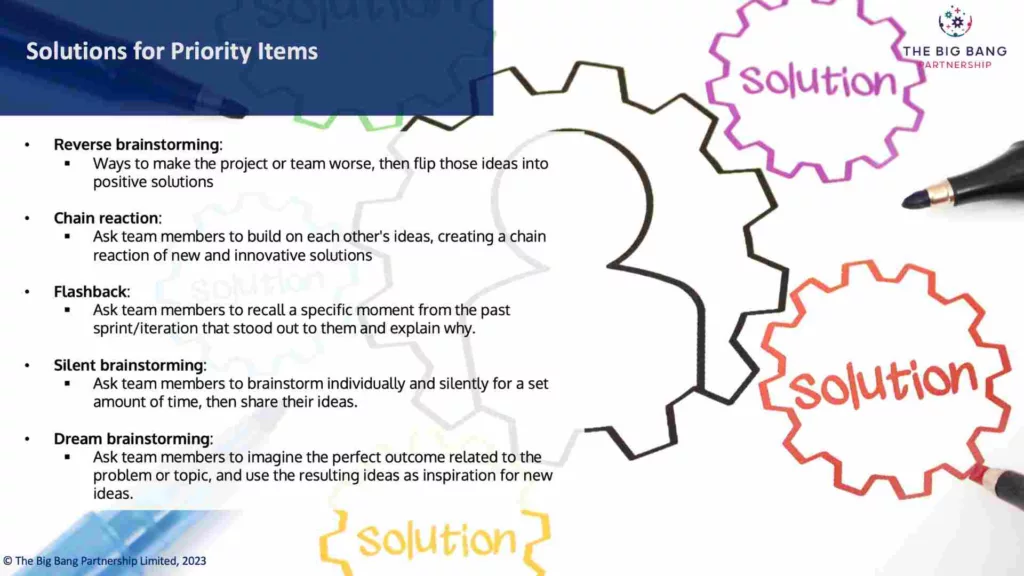
1. Reverse Brainstorming
Ask team members to brainstorm ideas for how to exacerbate or worsen the problem, rather than solve it. This can help shift the focus from the problem itself to the factors that contribute to it. Once everyone has shared all their ideas, flip them around and ask the team to brainstorm ways to mitigate or address these factors.
2. Chain Reaction
Start with a broad question or topic related to the issue or challenge and ask team members to share their ideas. Once someone has shared an idea, ask the next person to build on that idea or add a related idea.
Continue this process, with each person building on the ideas of the previous person, until you have generated a series of interconnected ideas.
Once you have shared all the ideas, discuss the commonalities among them and identify actionable steps to address the issue or challenge.
3. Flashback
Ask team members to reflect on their experiences with the project or process and identify a time when they felt particularly successful or accomplished. Once everyone has shared their flashback moment, discuss the commonalities among them and identify actionable steps to build on those successes in future projects.
4. Silent Brainstorming
Distribute sticky notes to each team member and ask them to silently brainstorm ideas related to the issue or challenge at hand.
Set a time limit for this individual brainstorming session.
Once time is up, have each team member share their ideas with the group, either by placing their sticky notes or on a whiteboard or by sharing them verbally.
5. Dream Brainstorming
Invite team members to imagine a future state in which all their wildest dreams related to the project or process have come true. Ask them to share their ideas and vision of this future state, including specific details and actionable steps.
Once everyone has shared their ideas, discuss the commonalities among them and identify actionable steps to work towards that dream state.
As a facilitator, encourage open communication and active listening, and avoid practical limitations or criticism.
Action plan
Now it’s time to select them and turn them into an action plan. Capture each of the actions that the team commits to taking, when they’re going to start it and finish it, and who’s going to do it.
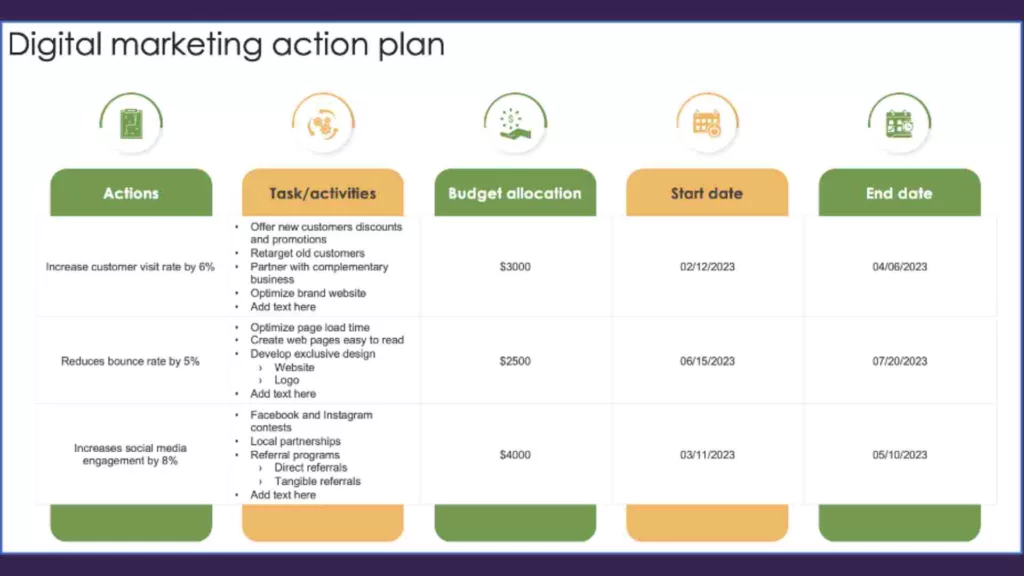
Agree action tracking and the next meeting date
Make sure that everyone is clear on how you will all track progress against each of the actions. Set the date for the next meeting, if you haven’t done so already. This will help you to keep the momentum going. Otherwise, your retrospective meeting risks becoming one of those events that people invest in, but nothing changes afterwards.
Level up your retrospective meetings
You now have a retrospective meeting agenda template, with a menu of 25 different activities that you can choose from. They’re all simple, easy-to-facilitate activities. All you need are some sticky notes, a whiteboard, a flip chart and some pens, or a virtual whiteboard such as Miro or Mural if you’re working virtually.
Keep your activities fresh. Don’t keep rehashing the same-old, same-old, because there’s probably an infinite number of different retrospective activities you could be using. Change it up a bit, keep it different, and keep building your culture of feedback and continuous improvement.
With great facilitation, your retrospective meetings can really help you to skyrocket your growth, efficiency, productivity, and the sense of team, which is really, really important.
You also now have a checklist to help you make sure that your retrospective meeting is productive and fun, as well as some tips on how to handle difficult or sensitive situations.
If there’s anything else that you need help with, please do get in touch via the contact us page. I’m always happy to chat with you over email or a virtual coffee.

